Dinkinesh, less than half a mile, or 1 kilometer, wide, circles the Sun in the main belt of asteroids located between the orbits of Mars and Jupiter. Lucy has been visually tracking Dinkinesh since Sept. 3; it will be the first of 10 asteroids Lucy will visit on its 12-year voyage. To observe so many, Lucy will not stop or orbit the asteroids, instead it will collect data as it speeds past them in what is called a “flyby.”
22.10.2023
NASA's Lucy probe will fly by a 'dinky' asteroid on Nov. 1. Here's what to expect
On Nov. 1, NASA's Lucy probe will fly by the space rock Dinkinesh as a test of its systems before heading to the Trojan asteroids in Jupiter's orbit.
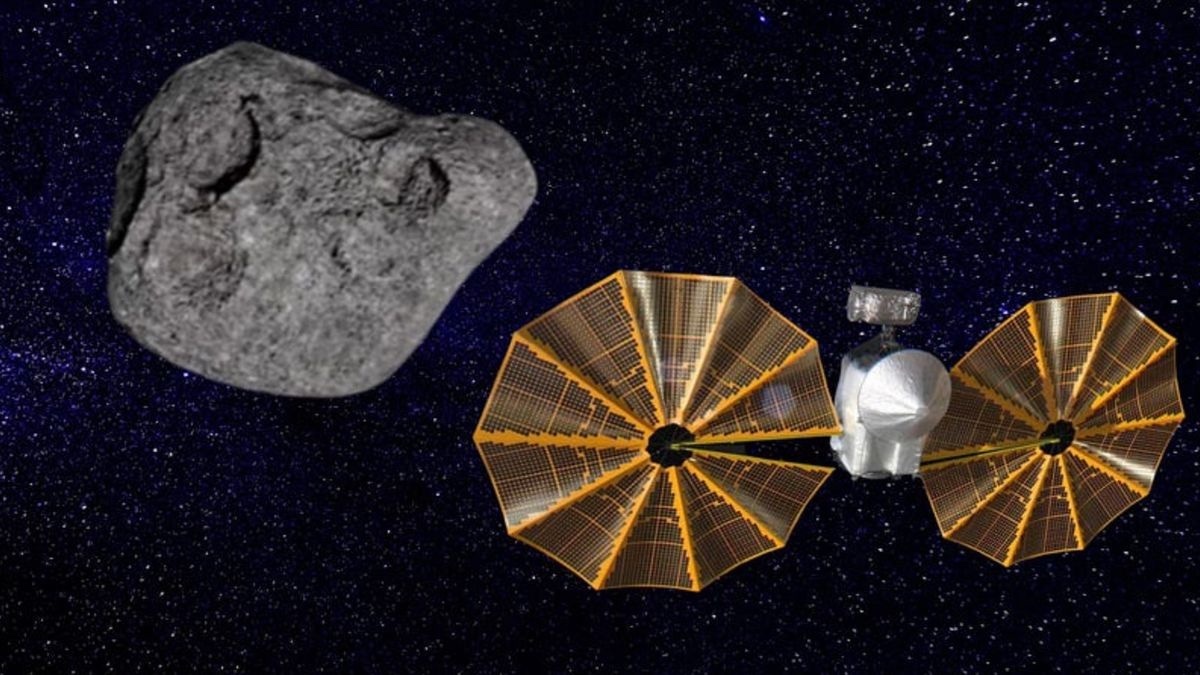
NASA's Lucy probe will fly by the space rock Dinkinesh on Nov. 1, and an agency video gives us a preview of the encounter.
Dinkinesh is located in the main asteroid belt between Mars and Jupiter and will be the first asteroid in Lucy's record-breaking tour, which will see the spacecraft visit nine other space rocks. These future destinations for Lucy are Trojanasteroids, which share the orbit of the solar system's largest planet, Jupiter.
The Lucy mission, which launched in October 2021, was not originally set to visit the 0.5-mile-wide (0.8 kilometers) Dinkinesh, previously known by the designation 1999 VD57; the decision to add it to the spacecraft's itinerary was made in January 2023. This will be more than a sightseeing jaunt, however. While at Dinkinesh, Lucy will test its innovative Terminal Tracking System, which is designed to keep its instruments pointed at asteroids during flybys.
That's not as easy or straightforward as it may sound. During its final approach to Dinkinesh, Lucy will be racing toward the space rock at 10,000 mph (16,000 kph) — about six times faster than a bullet fired by a rifle.
The NASA video explains that the Dinkinesh encounter presents the perfect opportunity to test this system. The geometry of the flyby — in particular, the angle at which Lucy will approach Dinkinesh in relation to the sun — is very similar to the mission's planned Trojan asteroid encounters.
That means that the encounter between Lucy and Dinkinesh acts essentially as a "dress rehearsal" for the probe's encounters with its main scientific targets. This will be a more challenging test, as Dinkinesh is smaller than the other Lucy targets — in fact, it will be the smallest main belt asteroid ever imaged up close by a spacecraft.
Following its encounter with Dinkinesh, Lucy will move away from the edge of the main asteroid belt, where the space rock is located, and head back to Earthfor a gravity assist in December 2024 that will send it hurtling toward the Trojan asteroids. It will fly by another main belt asteroid in 2025, then arrive at one set of Jupiter Trojan asteroids in 2027.
"This is really a tiny little asteroid," Lucy principal investigator Hal Levison said in a statement in February of this year, when Dinkinesh was given its name. ("Dinkinesh" is the Ethiopian name for the famous human-ancestor fossil Lucy, which was found in that nation.)
"Some of the team affectionately refer to it as 'Dinky,'" Levison added. "But, for a small asteroid, we expect it to be a big help for the Lucy mission."
Quelle: SC
----
Update: 25.10.2023
.
NASA’s Lucy Spacecraft Preparing for its First Asteroid Flyby
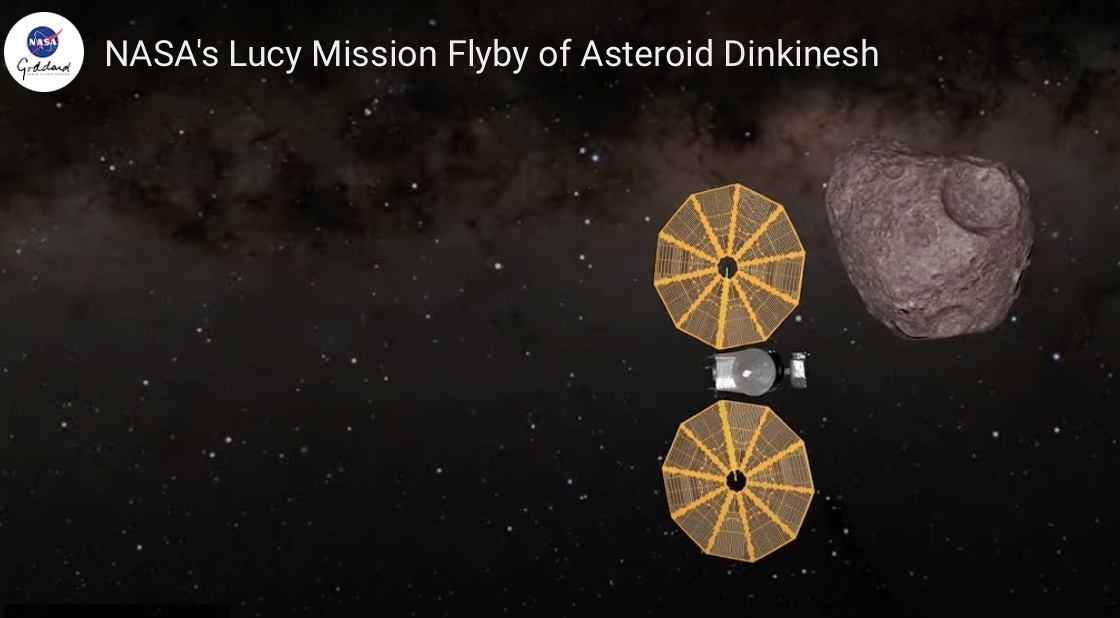
NASA’s Lucy spacecraft is preparing for its first close-up look at an asteroid. On Nov. 1, it will fly by asteroid Dinkinesh and test its instruments in preparation for visits in the next decade to multiple Trojan asteroids that circle the Sun in the same orbit as Jupiter.
“This is the first time Lucy will be getting a close look at an object that, up to this point, has only been an unresolved smudge in the best telescopes,” said Hal Levison, Lucy principal investigator from the Southwest Research Institute, which is headquartered in San Antonio. “Dinkinesh is about to be revealed to humanity for the first time.”
The primary aim of the Lucy mission, which launched Oct. 16, 2021, is to survey the Jupiter Trojan asteroids, a never-before-explored population of small bodies that orbit the Sun in two “swarms” that lead and follow Jupiter in its orbit. However, before Lucy gets to the Trojans, it will fly by another main belt asteroid in 2025 called Donaldjohanson for additional in-flight tests of the spacecraft systems and procedures.
During the Dinkinesh flyby, the team will test its terminal-tracking system that will allow the spacecraft to autonomously pinpoint the location of the asteroid, keeping it within the instruments’ field-of-view throughout the encounter.
As this encounter is intended as a test of Lucy’s systems, scientific observations will be simpler than for the mission’s main targets. The spacecraft and the platform that holds the instruments will move into position two hours before the closest approach to Dinkinesh. Once in place, the spacecraft will begin collecting data with its high-resolution camera (L’LORRI) and its thermal-infrared camera (L’TES). One hour before closest approach, the spacecraft will begin tracking the asteroid with the terminal-tracking system. Only in the last eight minutes will Lucy be able to collect data with MVIC and LEISA, the color imager and infrared spectrometer that comprise the L’Ralph instrument. Lucy’s closest approach is expected to occur at 12:54 p.m. EDT, when the spacecraft will be within 270 miles (430 kilometers) of the asteroid. Lucy will perform continuous imaging and tracking of Dinkinesh for almost another hour. After that time, the spacecraft will reorient itself to resume communications with Earth but will continue to periodically image Dinkinesh with L’LORRI for the next four days.
“We’ll know what the spacecraft should be doing at all times, but Lucy is so far away it takes about 30 minutes for radio signals to travel between the spacecraft and Earth, so we can’t command an asteroid encounter interactively,” said Mark Effertz, Lucy chief engineer at Lockheed Martin Space in Littleton, Colorado. “Instead, we pre-program all the science observations. After the science observations and flyby are complete, Lucy will reorient its high-gain antenna toward Earth, and then it will take nearly 30 minutes for the first signal to make it to Earth.”
After confirming the spacecraft's health, engineers will command Lucy to send science data of the encounter to Earth. This data downlink will take several days.
While the primary goal of the Dinkinesh encounter is an engineering test, mission scientists hope to also use the captured data to glean insights about the link between larger main belt asteroids explored by previous NASA missions and the smaller near-Earth asteroids.
After the Dinkinesh encounter, the Lucy spacecraft will continue in its orbit around the Sun, returning to the Earth’s vicinity for its second gravity assist in December 2024. This push from Earth will send it back to the main asteriod belt for its 2025 Donaldjohanson flyby, and then on to the Jupiter Trojan asteroids in 2027.
Lucy’s principal investigator is based out of the Boulder, Colorado, branch of Southwest Research Institute, headquartered in San Antonio. NASA’s Goddard Space Flight Center in Greenbelt, Maryland, provides overall mission management, systems engineering, and safety and mission assurance. Lockheed Martin Space in Littleton, Colorado, built the spacecraft. Lucy is the 13th mission in NASA’s Discovery Program. NASA’s Marshall Space Flight Center in Huntsville, Alabama, manages the Discovery Program for the Science Mission Directorate at NASA Headquarters in Washington.
NASA’s Lucy Asteroid Mission Zips Past a ‘Dinky’ Space Rock
NASA’s Lucy mission is starting its science studies way ahead of schedule
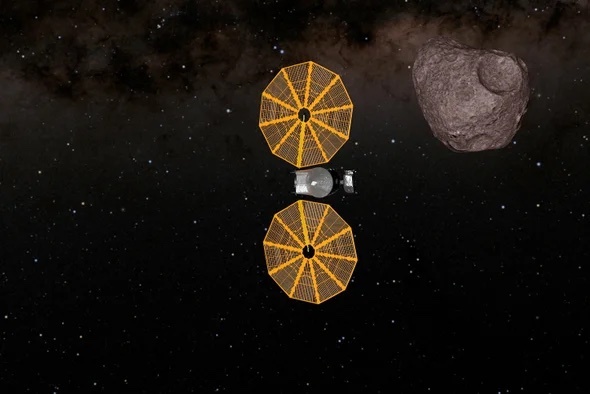
On November 1 a NASA spacecraft called Lucy will introduce humans to a world called Dinkinesh—nicknamed Dinky—the smallest main-belt asteroid we’ve ever seen up close.
Lucy launched in 2021 to explore a mysterious group of asteroids called Jupiter’s Trojans. These space rocks orbit the sun at the same distance as Jupiter in two clusters: one cluster races ahead of the gas giant while the other trails behind the planet. All told, scientists know of more than 12,000 of these objects in Jupiter’s orbit, and they think this eclectic group of primitive space rocks could help decode the solar system’s early history. Hence Lucy will zip past six of Jupiter’s Trojans beginning in 2027.
“The goal of Lucy is to understand the diversity of Trojans,” says Hal Levison, a planetary scientist at the Southwest Research Institute in Colorado and principal investigator on the Lucy mission. “In order to do that, you need to visit lots of objects, which is what we’re doing, and in order to do that, you need to be hauling ass.”
Lucy is moving so quickly that the mission’s primary science observations total just 24 hours spread across the spacecraft’s 12-year trek around the solar system, Levison says. The mission is only flying past its targets, not making extended stays—and once the probe has left an asteroid, that’s it. “There’s no going back; there’s no do-overs,” he says.
So when mission personnel realized that as Lucy trekked through the outer solar system, it would fly within 40,000 miles of a small, then nameless asteroid, they decided to detour for a dress rehearsal and nudged the mission’s trajectory to pass just 280 miles from the tiny body. Because of Dinkinesh’s alignment with the sun and the spacecraft during the flyby, the maneuver will better mimic future planned Trojan flybys than the mission’s original first target, another main-belt asteroid Lucy is set to encounter in 2025.
(The Lucy mission takes its name from an ancient hominin fossil found in northern Ethiopia that suggested that some 3.2 million years ago, early human relatives were walking on two feet; in Amharic, the fossil is called Dinkinesh. The spacecraft’s 2025 target, asteroid Donaldjohanson, is named for the paleoanthropologist who led the excavation that unearthed Lucy in 1974.)
In addition, Lucy’s science team has more cause for anxiety about the flybys than it would have hoped. During the months following Lucy’s launch, spacecraft personnel struggled to fully unfurl one of the probe’s two circular solar arrays before eventually concluding the mission was okay to proceed just shy of fully locking the array in place. The spacecraft’s good performance during a flyby of Earth last fall validated this decision, but the unlatched array could cause the spacecraft—and its instruments—to shake more than planned while performing flyby observations, potentially lowering the quality of Lucy’s data. Testing the procedure on Dinkinesh will give the team enough time to adjust the probe’s approach to each Trojan target if needed to ensure sharp images and measurements.
So for Lucy, Dinkinesh is first and foremost an engineering test and a practice run. But planetary scientists—who never turn down an opportunity to see something new in the solar system—are excited for their glimpse of the little space rock.
“The science is a bonus, but bonus science is always really interesting in my experience,” says Jessica Sunshine, a planetary scientist at the University of Maryland and a Lucy co-investigator. “Collectively, in planetary science, we’ve never flown by an object and went, ‘Eh, well, that was kind of boring.’”
When Dinkinesh was formally added to Lucy’s itinerary earlier this year, scientists knew only its location and unimpressive size. “We knew it was kind of small—but nothing else, actually,” says Julia de León, a planetary scientist at the Institute of Astrophysics of the Canary Islands who is not on the Lucy mission but helped coordinate some preparatory peeks at Dinkinesh. “So we all did our best,” she says, with astronomers hustling to telescopes to learn more about the asteroid.
Thanks to those efforts, scientists now have a somewhat better picture of Dinkinesh, which is shaping up to be an intriguing little space rock: rich in silica, roughly oblong and sedately spinning, with an estimated diameter of circa 900 meters and a day about twice the length of Earth’s 24-hour diurnal period.
In the main asteroid belt between Mars and Jupiter, scientists have only visited much larger space rocks, such as the Dawn mission’s targets, the asteroid Vesta and the dwarf planet Ceres, which are among the largest known objects in the belt. Both are hundreds of times larger than Dinkinesh. “It is by far the smallest thing we’ve ever seen in the main belt,” Sunshine says of Lucy’s tiny target.
Dinkinesh appears similar in scale to a few near-Earth asteroids that spacecraft have recently seen up close, however. These include carbon-rich Bennu, samples of which NASA’s OSIRIS-REx mission recently delivered to Earth, as well as Didymos, which NASA’s Double Asteroid Redirection Test (DART) mission zipped past on its way to impacting the asteroid’s small moon, Dimorphos.
Comparing Dinkinesh and Didymos should be particularly interesting, Sunshine says, because the two asteroids are made of the same type of material type and are similar sizes, just in different locations. “It’s rare that we get to have that sort of direct comparison in our line of science, so I was very excited when this became an obvious flyby target for Lucy,” she says.
Such a direct comparison is particularly valuable because scientists believe that near-Earth asteroids hail from the main belt, having been kicked deeper into the solar system by past gravitational perturbations. So scientists hope that Lucy’s glimpse of Dinkinesh will help them understand the changes main-belt asteroids undergo as they transform into near-Earth asteroids. “It will be like studying a near-Earth asteroid at its source region, where it’s generated,” de León says.
Lucy’s flyby of Dinkinesh will firm up scientists’ preliminary estimates of the asteroid’s basic shape and composition and will also allow them to count craters on its surface to better calibrate its age. And specific science questions aside, asteroid experts are just excited to see another of the solar system’s space rocks snap into focus.
“It’s going to be amazing to see those [images] come down,” Sunshine says. “It doesn’t get old; I’ll tell you that much.”
Quelle: SCIENTIFIC AMERICAN
+++
NASA's Lucy spacecraft successfully completes 1st flyby of asteroid 'Dinky'
On Nov. 1, Lucy hit a major milestone in its journey to reveal our solar system's past.
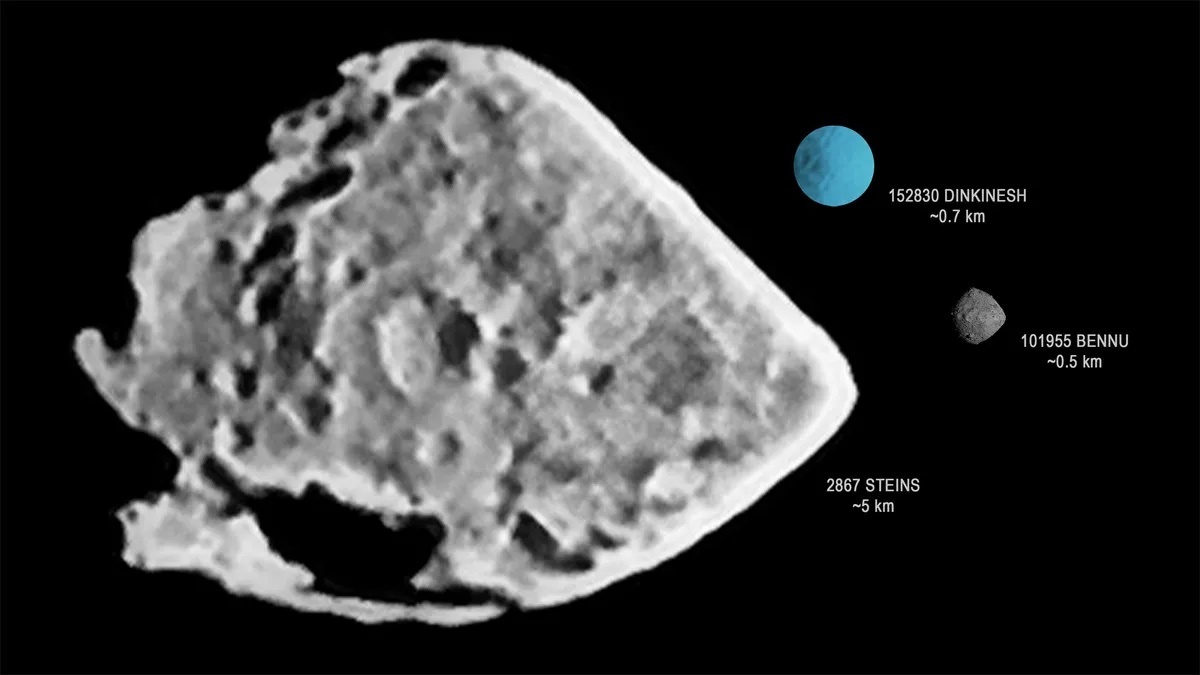
A size comparison of Dinkinesh (shown in blue) and other main asteroid belt objects Bennu and (2867) Steins. (Image credit: NASA/Goddard/University of Arizona)
On Nov. 1, NASA confirmed its Lucy spacecraft successfully completed a flyby of asteroid Dinkinesh, a relatively small space rock located in the main belt between Mars and Jupiter. This marks a milestone in Lucy's journey, as Dinkinesh, or 'Dinky,' is the first of 10 asteroids the probe will visit over the next 12 years.
"Based on the information received, the team has determined that the spacecraft is in good health," NASA officials wrote in a blog post after the flyby occurred. "The team has commanded the spacecraft to start downlinking the data collected during the encounter."
In a nutshell, the Lucy mission is part of NASA's ambitious endeavor to unveil secrets of our solar system's past. Though Lucy will also be passing by a few relatively nearby asteroids like Dinky, the probe's main goal is to fly by a few more distant Trojan asteroids orbiting the sun alongside Jupiter like bundles of pebbles bound to the gravitational tides of a giant boulder. Scientists are interested in learning more about those Trojans because they're believed to be ancient relics of the solar system, like extra Lego bricks from the box that built the planets.
Lucy's flyby of Dinkinesh can be thought of as a test-run in this regard, as many of the spacecraft's instruments have now been oiled while collecting data about this first asteroid encounter — including a color imager, high-resolution camera and infrared spectrometer.
According to the blog post, data from these tools will take about a week to be downlinked to Earth, and the team is "looking forward to seeing how the spacecraft performed during this first in-flight test of a high-speed asteroid encounter."
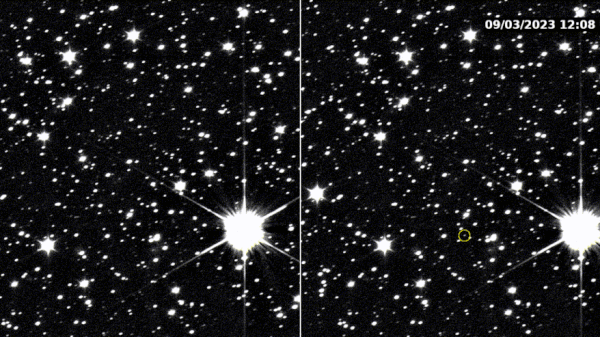
The yellow circle represents Dinkinesh. This is a visual Lucy snagged of the asteroid far prior to the approach. (Image credit: NASA/Goddard/SwRI/Johns Hopkins APL
Next, Lucy will head back to Earth for a gravity assist that'll help it zoom toward its second asteroid target: 52246 Donaldjohanson — named after co-discoverer of the Lucy fossil (representative of one the earliest human ancestors, for which the spacecraft is named), American paleoanthropologist Donald Johanson. And if you were wondering, "Dinkinesh" is just another title for the Lucy fossil.
It also means "you are marvelous," as you are, Lucy.
Quelle: SC
----
Update: 4.11.2023
.
NASA’s Lucy Spacecraft Discovers 2nd Asteroid During Dinkinesh Flyby
On Nov. 1, NASA’s Lucy spacecraft flew by not just its first asteroid, but its first two. The first images returned by Lucy reveal that the small main belt asteroid Dinkinesh is actually a binary pair.
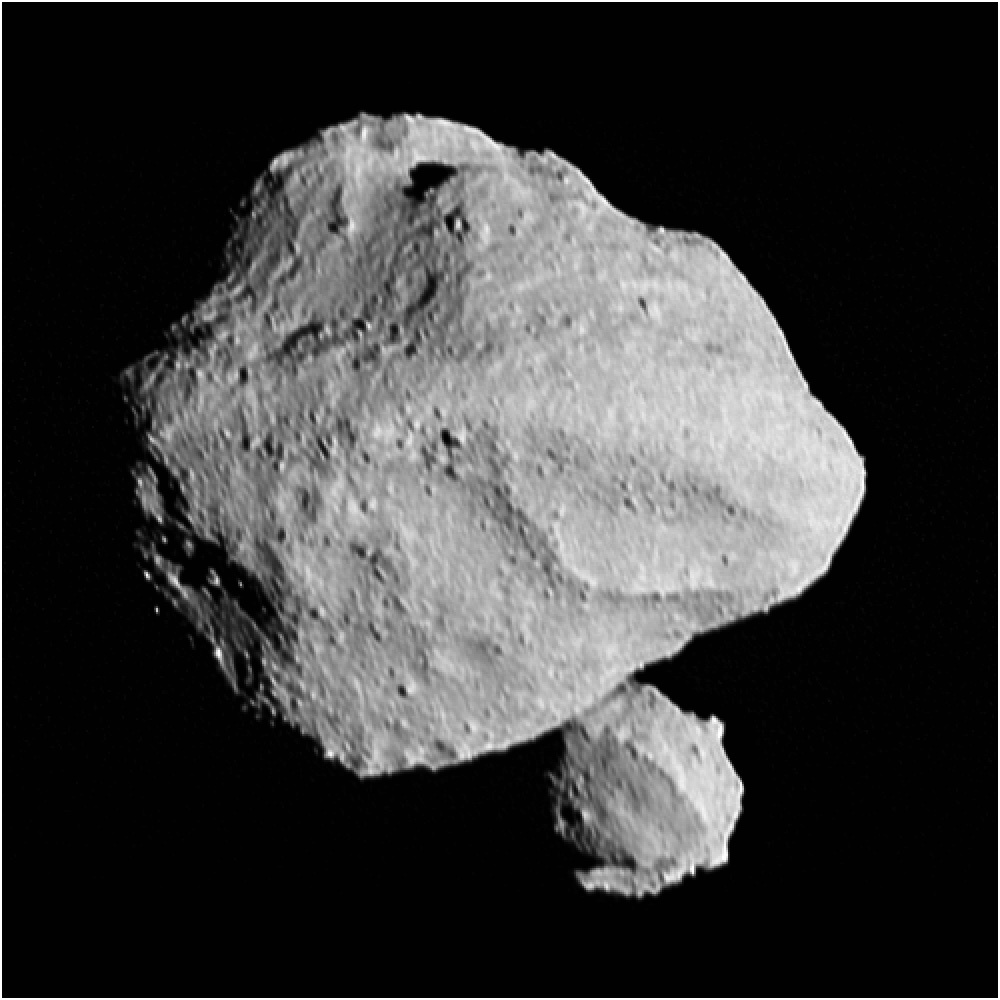
“Dinkinesh really did live up to its name; this is marvelous,” said Hal Levison, referring to the meaning of Dinkinesh in the Amharic language, “marvelous.” Levison is principal investigator for Lucy from the Boulder, Colorado, branch of the San-Antonio-based Southwest Research Institute. “When Lucy was originally selected for flight, we planned to fly by seven asteroids. With the addition of Dinkinesh, two Trojan moons, and now this satellite, we’ve turned it up to 11.”
In the weeks prior to the spacecraft’s encounter with Dinkinesh, the Lucy team had wondered if Dinkinesh might be a binary system, given how Lucy’s instruments were seeing the asteroid’s brightness changing with time. The first images from the encounter removed all doubt. Dinkinesh is a close binary. From a preliminary analysis of the first available images, the team estimates that the larger body is approximately 0.5 miles (790 m) at its widest, while the smaller is about 0.15 miles (220 m) in size.
This encounter primarily served as an in-flight test of the spacecraft, specifically focusing on testing the system that allows Lucy to autonomously track an asteroid as it flies past at 10,000 mph, referred to as the terminal tracking system.

“This is an awesome series of images. They indicate that the terminal tracking system worked as intended, even when the universe presented us with a more difficult target than we expected,” said Tom Kennedy, guidance and navigation engineer at Lockheed Martin in Littleton, Colorado. “It’s one thing to simulate, test, and practice. It’s another thing entirely to see it actually happen.”
While this encounter was carried out as an engineering test, the team’s scientists are excitedly poring over the data to glean insights into the nature of small asteroids.
“We knew this was going to be the smallest main belt asteroid ever seen up close,” said Keith Noll, Lucy project scientist from NASA’s Goddard Space Flight Center in Greenbelt, Maryland. “The fact that it is two makes it even more exciting. In some ways these asteroids look similar to the near-Earth asteroid binary Didymos and Dimorphos that DART saw, but there are some really interesting differences that we will be investigating.”
It will take up to a week for the team to downlink the remainder of the encounter data from the spacecraft. The team will use this data to evaluate the spacecraft’s behavior during the encounter and to prepare for the next close-up look at an asteroid, the main belt asteroid Donaldjohanson, in 2025. Lucy will then be well-prepared to encounter the mission’s main targets, the Jupiter Trojan asteroids, starting in 2027.
Quelle: NASA
----
Update: 6.11.2023
.
NASA’s Lucy Spacecraft Hours Away from 1st Asteroid Encounter
We are only a few hours away from the NASA Lucy spacecraft’s first close up look at the small inner-main belt asteroid, Dinkinesh. Dinkinesh is 10 to 100 times smaller than the Jupiter Trojan asteroidsthat are the mission’s main targets. The Dinkinesh encounter serves as a first in-flight test of the spacecraft’s terminal tracking system.
Lucy’s closest approach will occur at 12:54 p.m. EDT (16:54 UTC) at a distance within 270 miles (430 km) of Dinkinesh. However, there won’t be much time to observe the asteroid at this distance as Lucy speeds past at 10,000 mph (4.5 km/s).
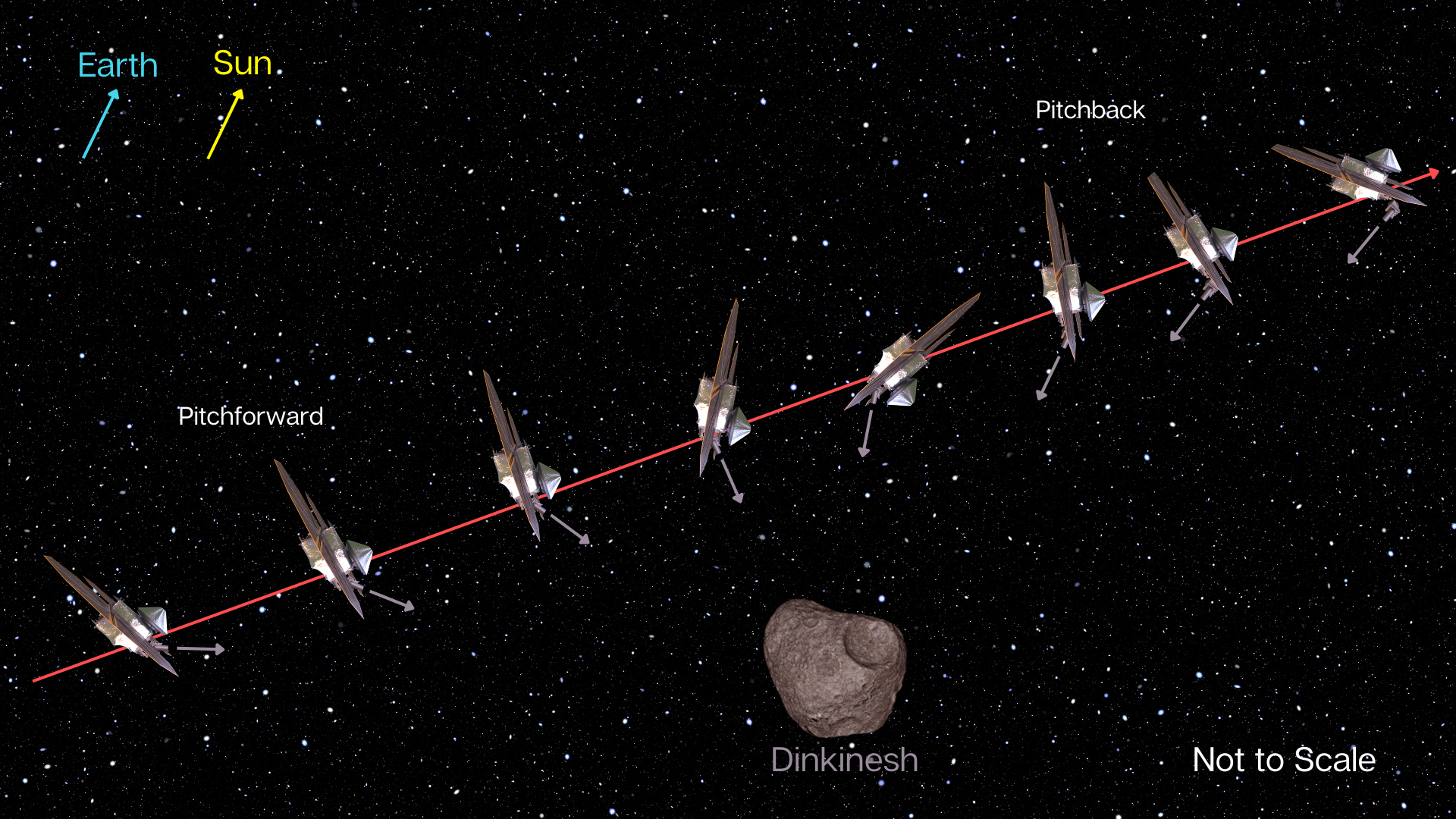
A graphic illustrating the expected motion of the NASA Lucy spacecraft and its instrument pointing platform (IPP) during the encounter with asteroid Dinkinesh. The spacecraft’s terminal tracking system is designed to actively monitor the location of Dinkinesh, enabling the spacecraft and IPP to move autonomously in order to observe the asteroid throughout the encounter. The yellow, blue, and grey arrows indicate the directions of the Sun, Earth, and Dinkinesh, respectively. The red arrow indicates motion of the spacecraft. An animation is available here. Credit: NASA/Goddard/SwRI
Two hours before closest approach, the spacecraft and the rotational platform that holds Lucy’s science instruments (the instrument pointing platform) will be commanded to move into encounter configuration. After this point, the spacecraft’s high-gain antenna will point away from the Earth and the spacecraft will not be able to return data for the remainder of the encounter.
Shortly thereafter, the high-resolution grayscale camera on Lucy, L’LORRI, will begin taking a series of images every 15 minutes. (L’LORRI, short for Lucy’s Long Range Reconnaissance Imager, is supplied by the Johns Hopkins Applied Physics Laboratory.) Dinkinesh has been visible to L’LORRI as a single point of light since early September when the team began using the instrument to assist with spacecraft navigation. The team estimates that at a distance of just under 20,000 miles (30,000 km), Dinkinesh may appear to be a few pixels in size, just barely resolved by the camera.
Additionally, Lucy’s thermal infrared instrument, L’TES, will begin collecting data. L’TES (formally the Lucy Thermal Emission Spectrometer, provided by Arizona State University) is not designed to observe an asteroid as small as Dinkinesh, so the team is interested to see if L’TES is able to detect the asteroid and measure its temperature during the encounter.
An hour before the closest approach, the spacecraft will begin actively tracking Dinkinesh using the onboard terminal tracking system. The spacecraft will use T2Cam (the Terminal Tracking Cameras, provided by Malin Space Science Systems), to repeatedly image the asteroid. In the minutes around closest approach, this system is designed to autonomously reorient the spacecraft and its instrument pointing platform as needed to keep the asteroid centered in the cameras’ field of view. Testing this system is the primary goal of this encounter.
Ten minutes before closest approach, the spacecraft is instructed to begin “closest approach imaging” with the L’LORRI instrument. In these images, taken every 15 seconds at three different exposure times, the asteroid will be several hundred pixels across, allowing the team an unprecedented view of this small main belt asteroid, which is estimated to be less than half a mile (1 km) in diameter.
Lucy will wait until about six minutes before closest approach to begin taking data with its color imager (the Multi-spectral Visible Imaging Camera, MVIC) and infrared spectrometer (Linear Etalon Imaging Spectral Array, LEISA), which together comprise the L’Ralph instrument (provided by NASA’s Goddard Space Flight Center in Greenbelt, Maryland).
About six minutes after the closest approach, L’Ralph will stop taking data, and Lucy will conclude the closest approach observations. By this time, the spacecraft will already be almost 1,700 miles (2,700 km) past the asteroid. Lucy will begin a maneuver referred to as a “pitchback” in which it reorients its solar arrays toward the Sun while the instrument pointing platform continues to autonomously track the asteroid as the spacecraft departs. This maneuver is designed to be carried out slowly to minimize spacecraft vibrations as the spacecraft moves its large solar arrays. L’LORRI will image Dinkinesh throughout this process to monitor spacecraft stability.
Once the spacecraft is over 8,000 miles (13,000 km) from the asteroid, Lucy will stop actively tracking the position of Dinkinesh. From that point on, the team expects the asteroid to remain visible to the spacecraft’s cameras without the need to reposition the spacecraft or instruments.
Two hours after closest approach, the L’TES instrument will be instructed to stop taking data. L’LORRI will continue periodically observing the asteroid for another four days to monitor the light curve of the asteroid.
Once Lucy turns its high-gain antenna back toward Earth, it will be able to resume communications, with an approximately 30-minute light-travel-time delay in each direction. The team expects to receive the first signal from the spacecraft within two hours of closest approach. After assessing the health and safety of the spacecraft, the team will command the spacecraft to begin downlinking the data taken during the encounter. It will take up to a week for all data to be returned to Earth via NASA’s Deep Space Network.
Quelle: NASA
----
Update: 9.11.2023
.
NASA’s Lucy Surprises Again, Observes 1st-ever Contact Binary Orbiting Asteroid
It turns out there is more to the “marvelous” asteroid Dinkinesh and its newly discovered satellite than first meets the eye. As NASA’s Lucy spacecraft continued to return data of its first asteroid encounter on Nov. 1, 2023, the team was surprised to discover that Dinkinesh’s unanticipated satellite is, itself, a contact binary – that is, it is made of two smaller objects touching each other.
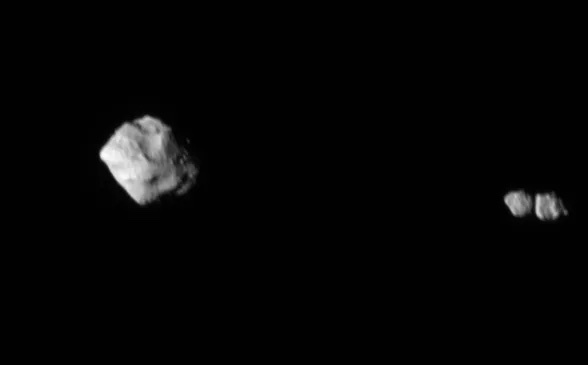
In the first downlinked images of Dinkinesh and its satellite, which were taken at closest approach, the two lobes of the contact binary happened to lie one behind the other from Lucy's point of view. Only when the team downlinked additional images, captured in the minutes around the encounter, was the true nature of this object revealed.
“Contact binaries seem to be fairly common in the solar system,” said John Spencer, Lucy deputy project scientist, of the Boulder, Colorado, branch of the San-Antonio-based Southwest Research Institute. “We haven’t seen many up-close, and we’ve never seen one orbiting another asteroid. We’d been puzzling over odd variations in Dinkinesh’s brightness that we saw on approach, which gave us a hint that Dinkinesh might have a moon of some sort, but we never suspected anything so bizarre!”
Lucy’s primary goal is to survey the never-before-visited Jupiter Trojan asteroids. This first encounter with a small, main belt asteroid was only added to the mission in January 2023, primarily to serve as an in-flight test of the system that allows the spacecraft to continually track and image its asteroid targets as it flies past at high speed. The excellent performance of that system at Dinkinesh allowed the team to capture multiple perspectives on the system, which enabled the team to better understand the asteroids’ shapes and make this unexpected discovery.
“It is puzzling, to say the least,” said Hal Levison, principal investigator for Lucy, also from Southwest Research Institute. “I would have never expected a system that looks like this. In particular, I don’t understand why the two components of the satellite have similar sizes. This is going to be fun for the scientific community to figure out.”
This second image was taken about 6 minutes after closest approach from a distance of approximately 1,010 miles (1,630 km). The spacecraft traveled around 960 miles (1,500 km) between the two released images.
“It’s truly marvelous when nature surprises us with a new puzzle,” said Tom Statler, Lucy program scientist from NASA Headquarters in Washington. “Great science pushes us to ask questions that we never knew we needed to ask.”
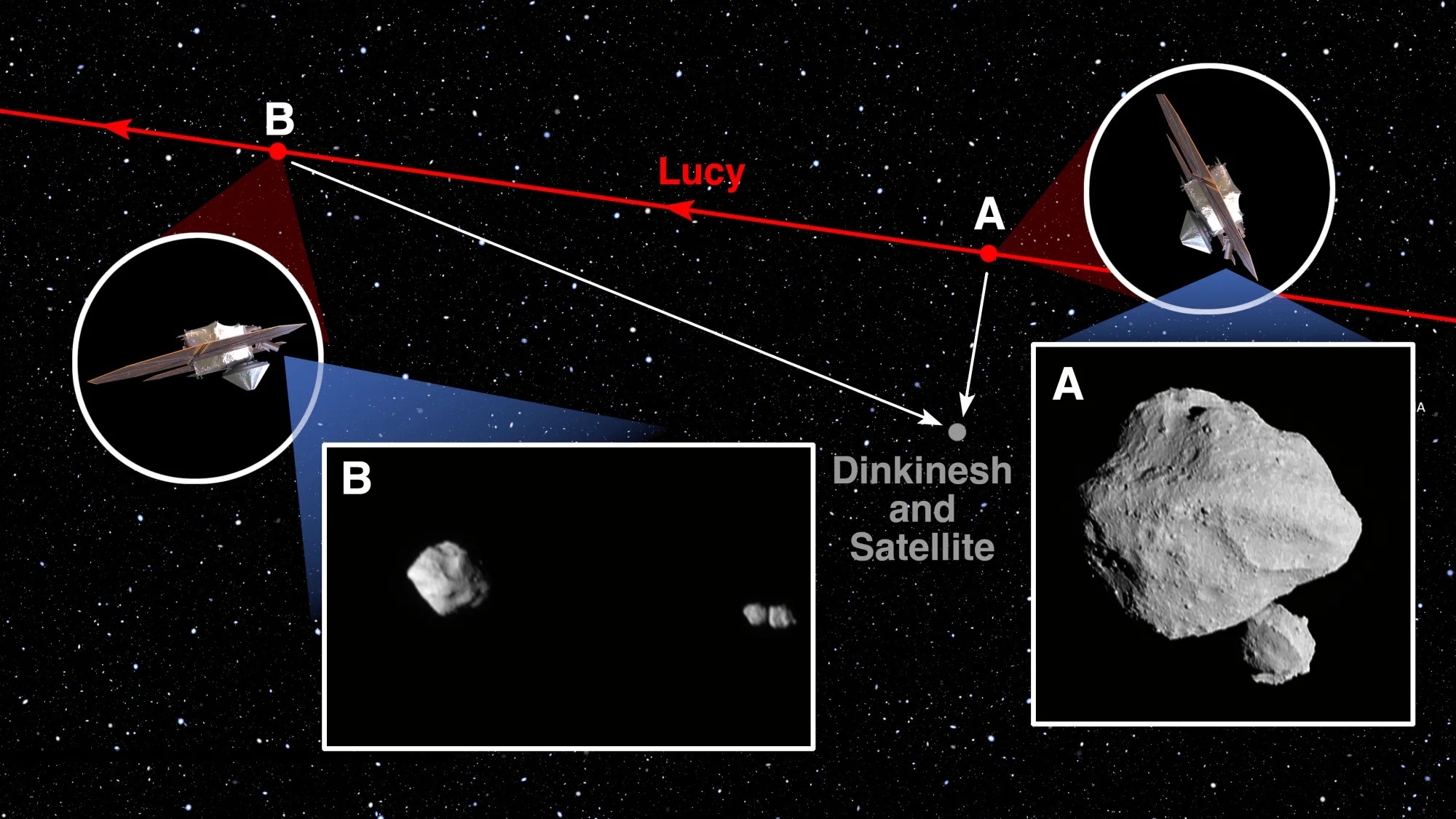
The team is continuing to downlink and process the remainder of the encounter data from the spacecraft. Dinkinesh and its satellite are the first two of 11 asteroids that Lucy plans to explore over its 12-year journey. After skimming the inner edge of the main asteroid belt, Lucy is now heading back toward Earth for a gravity assist in December 2024. That close flyby will propel the spacecraft back through the main asteroid belt, where it will observe asteroid Donaldjohanson in 2025, and then on to the Trojan asteroids in 2027.
Lucy’s principal investigator is based out of the Boulder, Colorado, branch of Southwest Research Institute, headquartered in San Antonio. NASA’s Goddard Space Flight Center in Greenbelt, Maryland, provides overall mission management, systems engineering, and safety and mission assurance. Lockheed Martin Space in Littleton, Colorado, built and operates the spacecraft. Lucy is the 13th mission in NASA’s Discovery Program. NASA’s Marshall Space Flight Center in Huntsville, Alabama, manages the Discovery Program for the Science Mission Directorate at NASA Headquarters in Washington.
Quelle: NASA
----
Update: 17.11.2023
.
Lucy Explores Three Asteroids for the Price of One
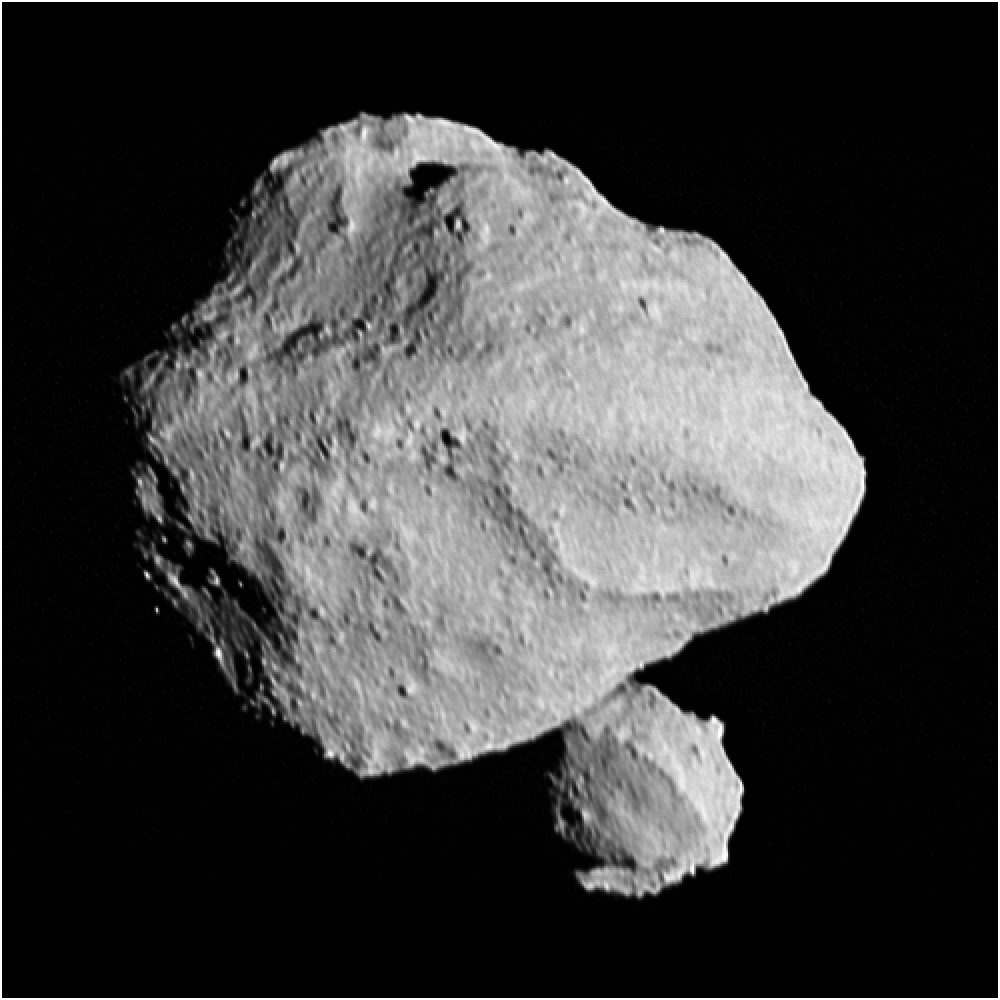
This is Lucy’s highest-resolution image of Dinkinesh (foreground) and its previously-unknown moon (background). Both objects have rocky surfaces. Credit: NASA/GSFC/SWRI.
On November 1st, NASA’s Lucy spacecraft flew by the small asteroid Dinkinesh. The spacecraft’s initial images of this diminutive 0.4-mile-wide world have already illustrated the capabilities of its instrument suite. High-resolution images reveal that Dinkinesh’s surface is strewn with boulders and that it is orbited by a small moon. Dinkinesh’s companion, in turn, is a contact binary comprised of two asteroids which were fused together during a gentle collision. The encounter was a major milestone in its own right, as every asteroid which we explore with a spacecraft has the potential to teach us more about the ingredients which formed the planets. However, this initial flyby was just a foretaste of the data which the Lucy spacecraft will return over the coming decade. Including Dinkinesh, Lucy will investigate eleven different planetesimals over the course of its mission.
Lucy is the 13th mission in NASA’s Discovery Program. This program allows scientists to design and propose novel small planetary science missions to NASA. As far as interplanetary spacecraft are concerned, Discovery missions are inexpensive, with development budgets of $500 million or less. These frequent, affordable flight opportunities balance out larger Flagship missions and allow NASA to explore a variety of destinations simultaneously. Prior Discovery missions included the Mars Pathfinder lander, the Stardust comet sample return mission, and the Dawn mission to orbit the dwarf planet Ceres.
Lucy was pitched as the first mission to Jupiter’s Trojan asteroids. The Trojans are a family of small bodies which were gravitationally rearranged by Jupiter during the early history of the Solar System. They are trapped in clusters which orbit two of Jupiter’s Lagrange points. At these locations, the gravitational forces of Jupiter and the Sun are balanced; these forces can hold smaller objects in place indefinitely. Jupiter’s Trojans lead and trail the planet in its orbit by 60 degrees.
While planetary scientists have not determined the origin of the Trojan asteroids, the red tint of some of these objects suggests that they might have been captured from the Kuiper belt. This broad zone of debris is located beyond the orbit of Neptune, and Pluto is its largest and most famous member. If this theory is correct, the Trojans might be rich in water ice and organic compounds. Along with carbonaceous asteroids such as OSIRIS-REx’s target, Bennu, they might have played an essential role in delivering the ingredients for life to Earth. Over the course of its mission, Lucy will fly by eight Trojans and map their surfaces to test the hypothesis that they are captured Kuiper Belt Objects.
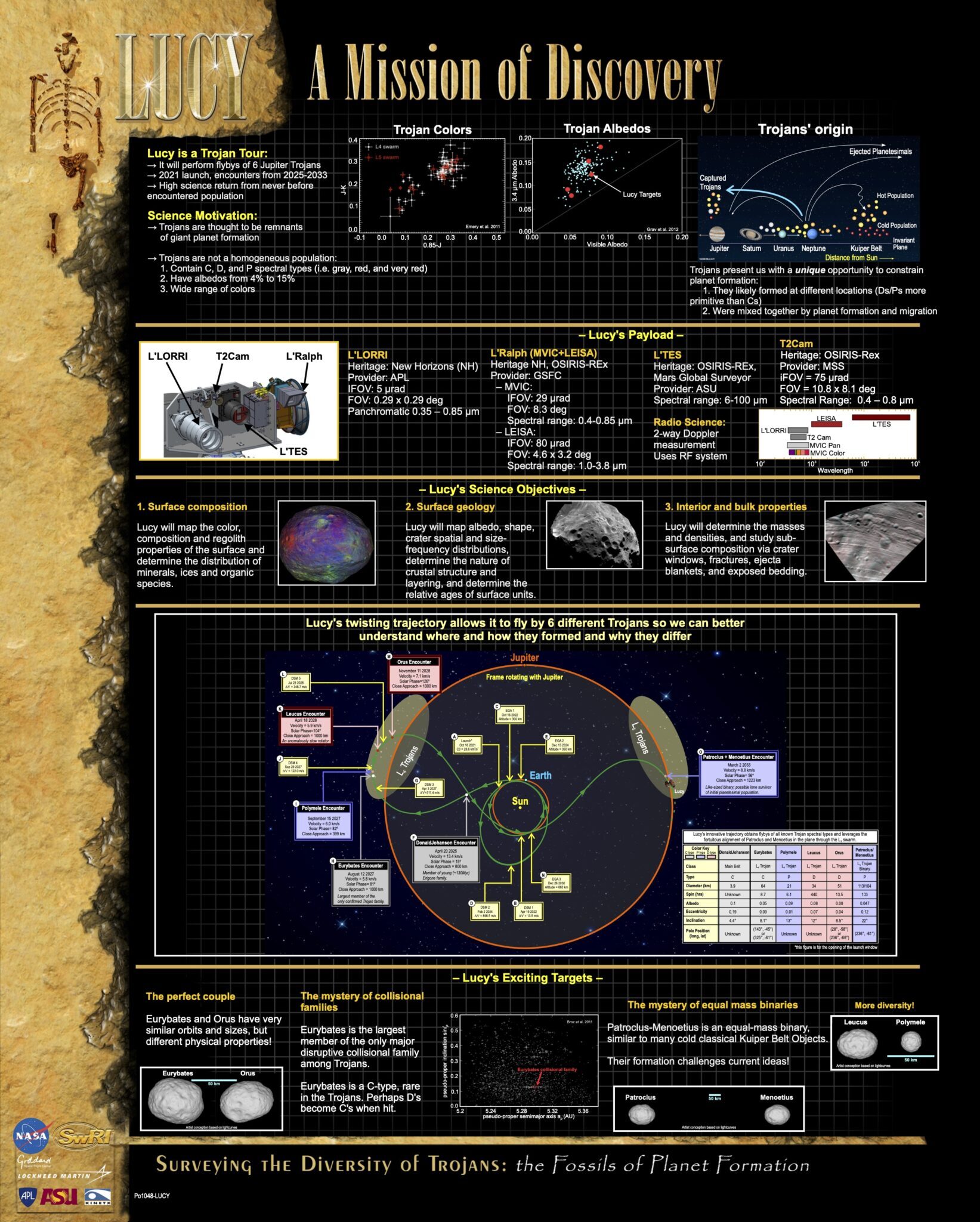
A poster created by the Lucy science team describes the mission’s targets and objectives in detail. Credit: NASA/GSFC/SWRI.
Dinkinesh was not originally on Lucy’s itinerary. However, the science team wanted to test the spacecraft’s instruments and software by observing a main belt asteroid before collecting vital data on the Trojans. In January of 2023, astronomer Raphael Marschall calculated that Lucy would pass just 40,000 miles from a small asteroid, then known as 1999 VD57. By conducting a small burn of the spacecraft’s thrusters, the team was able to tweak its trajectory to approach the asteroid at a reduced distance of 280 miles. They named their mission’s first target Dinkinesh, which is the Ethiopian name for the fossil of the early hominid Lucy. The mission’s namesake was one of the early ancestors of modern humans.
The primary goals of the flyby were to calibrate Lucy’s three instruments and to confirm that there are no errors in the software used to control them. The probe carries a telescopic camera (L’LORRI), a visible and near-infrared spectrometer (L’Ralph), and a thermal emission spectrometer (L’TES). Together, they allow planetary scientists to understand an asteroid’s composition, shape, and internal structure. The instruments are mounted on a scan platform, which will point them towards their target while the spacecraft remains stationary. The scan platform and its tracking cameras are some of the most innovative pieces of hardware on the spacecraft. The Dinkinesh flyby was intended to demonstrate that the scan platform can keep a small asteroid centered in the L’LORRI camera’s narrow field of view. Given that Lucy has already returned high-resolution photographs of the asteroid to Earth, it appears that this test was successful.
However, Lucy’s images of Dinkinesh are also valuable in their own right. The main belt of asteroids, located between Mars and Jupiter, is a debris field left over from the formation of the Solar System. As we learn more about this region, it is becoming apparent that this group of asteroids are not homogenous. Instead, they are an eclectic collection of stony, carbonaceous, icy, and metallic asteroids shepherded into their current orbits by the migration of the giant planets 3.9 billion years ago. Dinkinesh is the smallest main belt asteroid ever explored by a spacecraft. Therefore, Lucy’s flyby of this object will allow scientists to compare and contrast it to larger main belt asteroids explored by other spacecraft and investigate whether there is a link between the properties of an asteroid and its size.
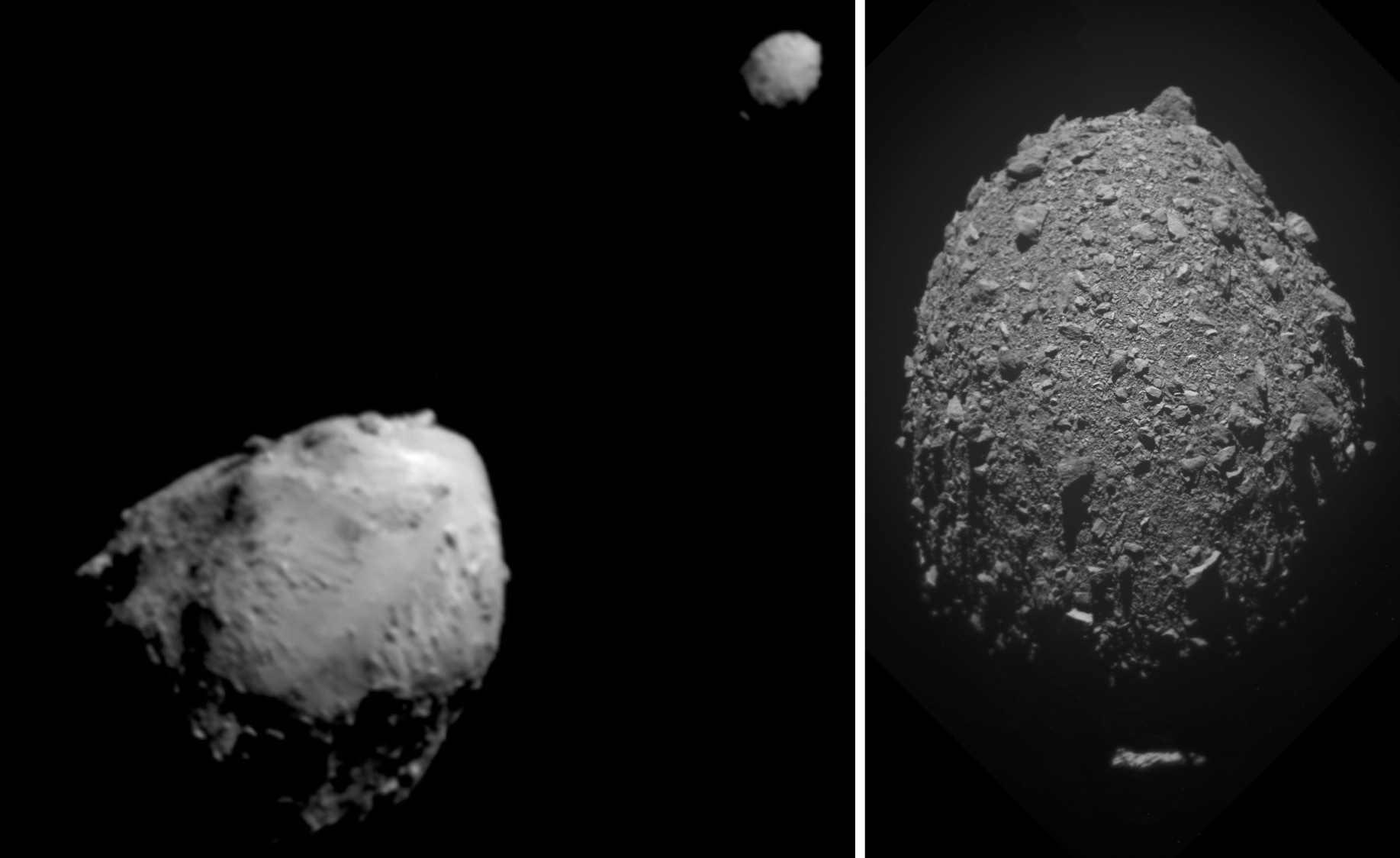
Left: The near-Earth asteroid Didymos (bottom left) and its satellite Dimorphos (top right) are seen in a DART image. Right: A higher-resolution photograph reveals that Dimorphos is a “rubble pile” asteroid. Credit: NASA.
When the Lucy science team received the first high-resolution images from Lucy two days after the flyby, they were in for a surprise. Dinkinesh is not one asteroid, but three. The highest-resolution L’LORRI image revealed that the 0.4-mile-wide asteroid is accompanied by a moon which is half its size. The surfaces of both asteroids are strewn with boulders. This implies that they might be “rubble pile” asteroids, which are collections of smaller rocks held together by their collective weak gravitational field. However, this theory can only be tested by measuring the density of Dinkinesh.
Lucy project scientist Keith Noll noted that there are some similarities between the Dinkinesh system and the near-Earth asteroid Didymos, which was the target of the DART impactor. Dimorphos is orbited by a satellite named Dimorphos, and in both systems, the diameter of the main asteroid is roughly double that of its moon. DART’s final images also show that Dimorphos is clearly a rubble pile. However, Noll also pointed out that “there are some really interesting differences that we will be investigating.” [1]
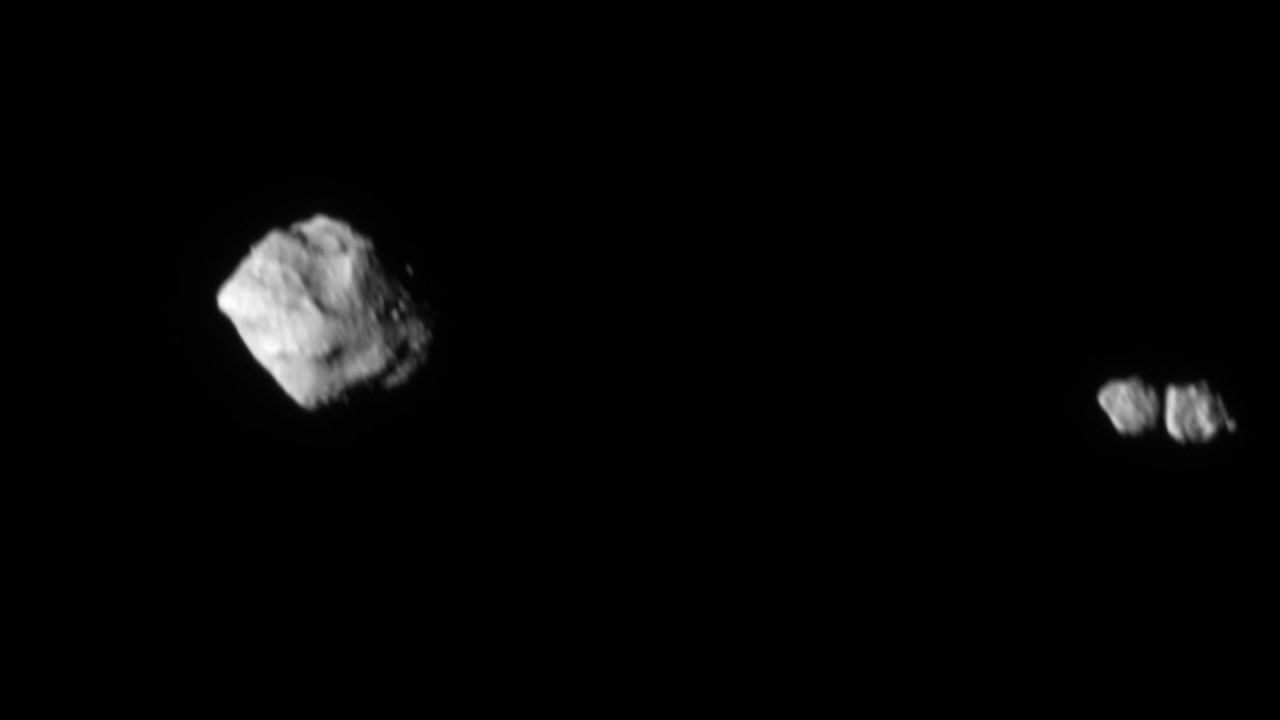
As the Dinkinesh system receded into the distance, Lucy captured an image which reveals that the small moon (right) is a contact binary created during a gentle collision between two objects. Credit: NASA/GSFC/SWRI.
Lower-resolution L’LORRI images captured from a different angle enabled another unexpected discovery. Dinkinesh’s moon is comprised of two smaller asteroids which have been fused together. This peanut-shaped configuration is known as a contact binary, and it is relatively common among the small, icy bodies of the Kuiper Belt. The most famous example is Arrokoth, which was visited by the New Horizons spacecraft in 2019. Contact binaries form when two objects in nearby orbits are gradually drawn together by weak gravitational interactions. They eventually collide at a walking pace, which leaves both objects relatively intact.
Contact binaries are scientifically intriguing because they can only form when the parent bodies are in concentric, circular orbits. This was true of most Kuiper Belt Objects prior to the migration of the giant planets. However, Dinkinesh’s moon is the first contact binary which we have observed in the asteroid belt. This raises several new questions. Did the contact binary form early in the history of the Solar System, and was it subsequently captured into orbit around Dinkinesh? Or did the asteroid originally have two moons, which gently collided? Is this configuration common among small asteroids, or are contact binaries relatively scarce? Additional analysis of the data from Lucy will be required to differentiate between these hypotheses and any other theories which arise.
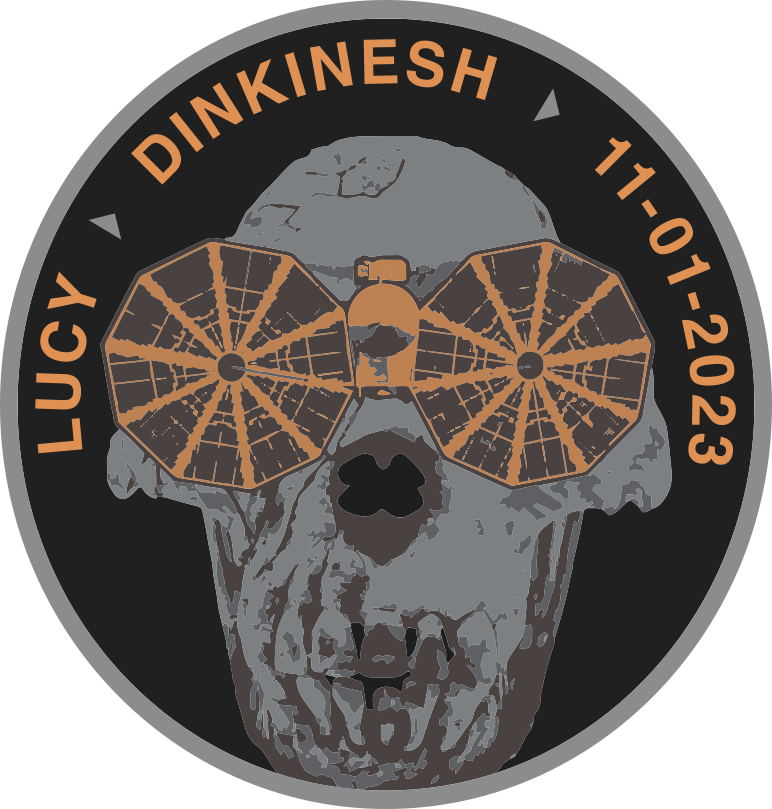
The Lucy team created a custom mission patch for the Dinkinesh flyby. The design is inspired by the fact that the encounter took place one day after Halloween. Credit: NASA/GSFC/SWRI.
Over the coming days, spectra of Dinkinesh will also be returned to Earth. These data require more processing than the L’LORRI images, so the results of these observations might not be released for several months. However, scientists already have a hypothesis about the asteroid’s composition based on telescopic data. The leading theory is that Dinkinesh is a S-type stony asteroid. These asteroids are rich in silicate minerals, such as olivine and feldspar, and they were likely the primary building blocks of Earth’s mantle. Lucy’s flyby of the asteroid Dinkinesh was wildly successful. Preliminary images from the spacecraft’s L’LORRI telescope have already revealed that the asteroid is accompanied by a unique binary moon. Image processing will undoubtedly expose additional details about the surface and internal structure of the asteroid. Lucy’s next asteroid flyby is slated for April 20th, 2025. The spacecraft will explore a larger main belt asteroid named after Donald Johansen, the discoverer of the Lucy fossil.
Quelle: AS
